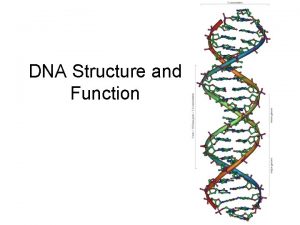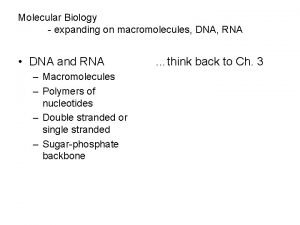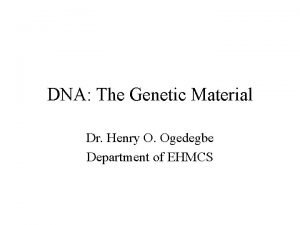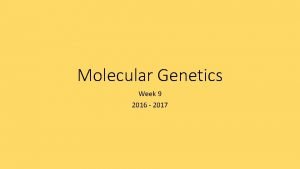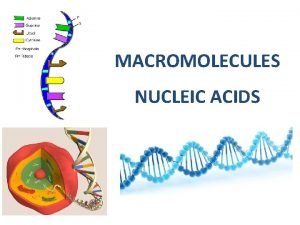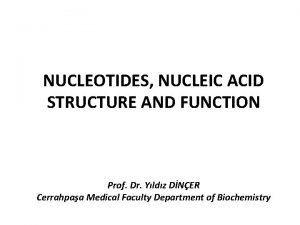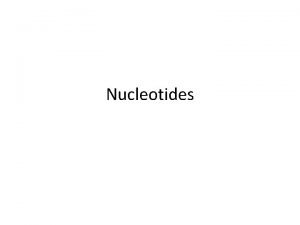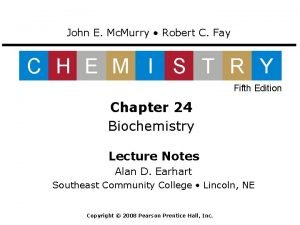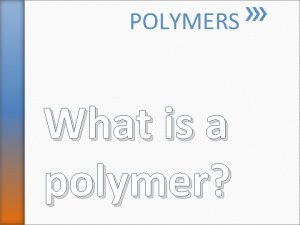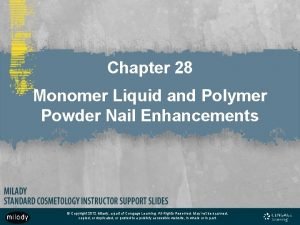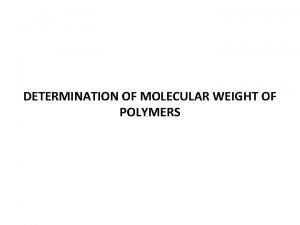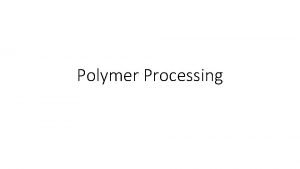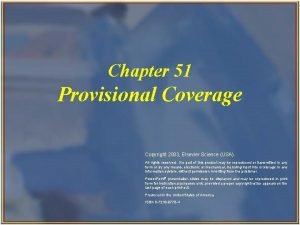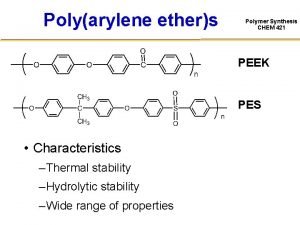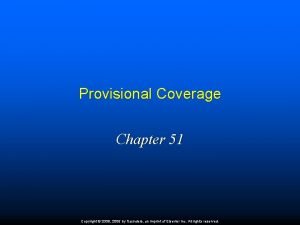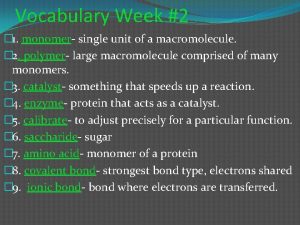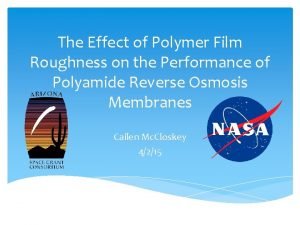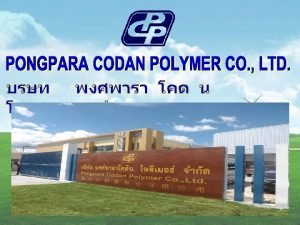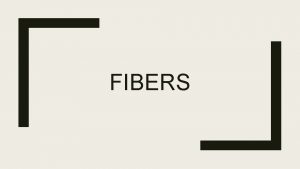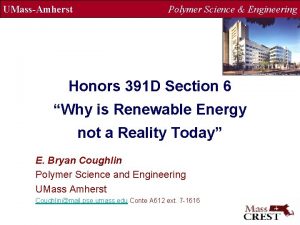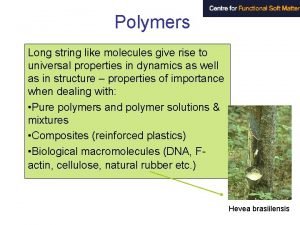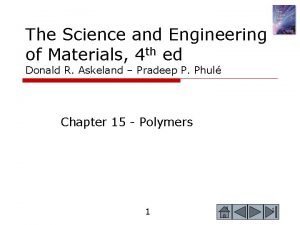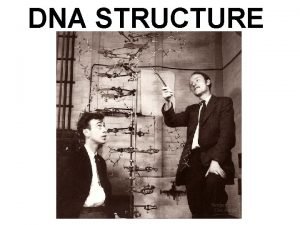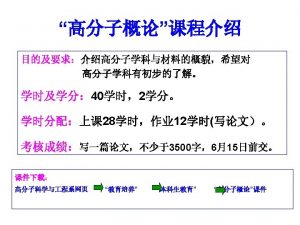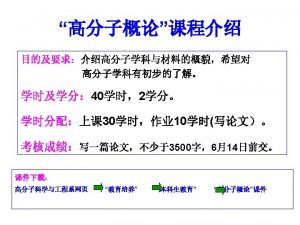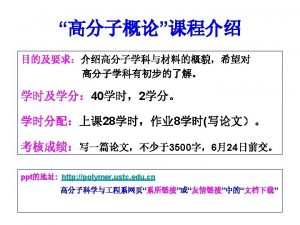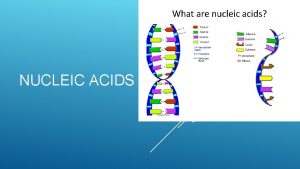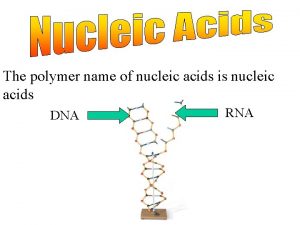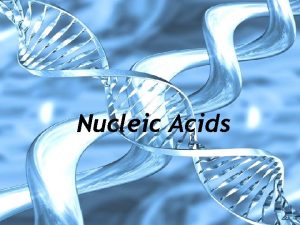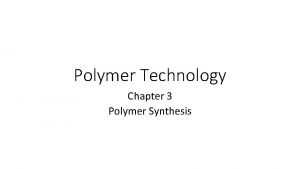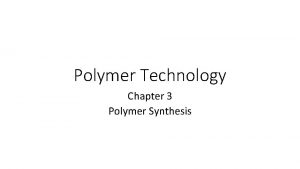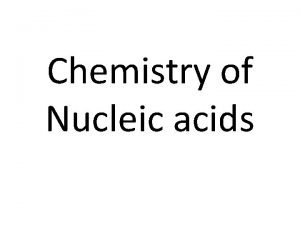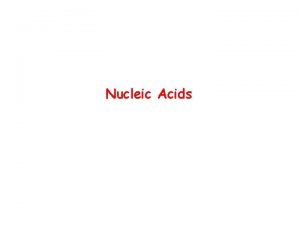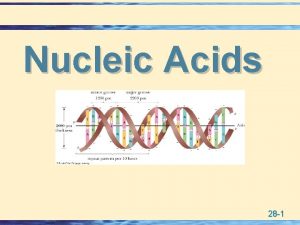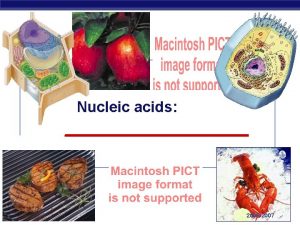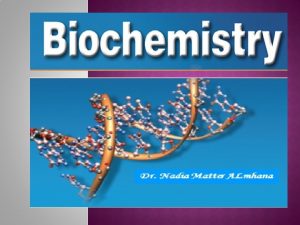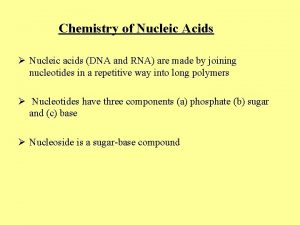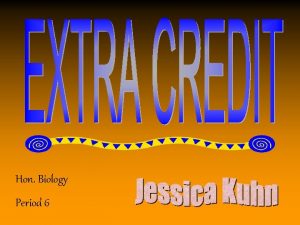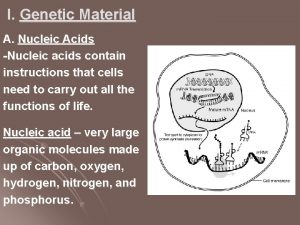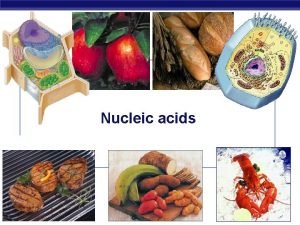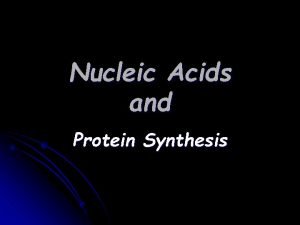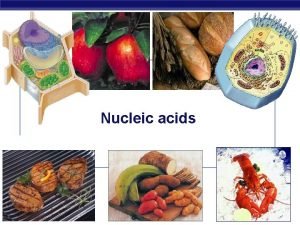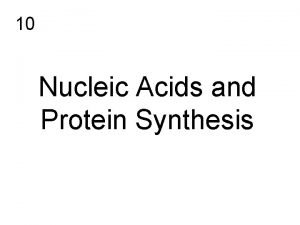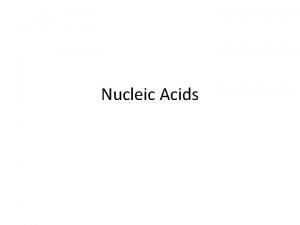Nucleic Acids Nucleic Acids Nucleic acids polymer are

































- Slides: 33

Nucleic Acids

Nucleic Acids Nucleic acids (polymer) are long chains of nucleotides (monomer). A nucleotide is composed of phosphate, sugar, and a nitrogen base.

Nucleic Acids There are 2 types of nucleic acids: 1. DNA 2. RNA Functions of nucleic acids: 1. Store/transmit genetic information 2. Instructions for making proteins

DNA

DNA stands for Deoxyribonucleic Acid. DNA is shaped as a double helix because it looks like a twisted ladder **Designed by Watson and Crick DNA contains our genetic information and is stored in chromosomes in the nucleus of our cells.


DNA The sugar for DNA is called deoxyribose sugar. Sugar

DNA Nitrogen Bases There are 2 groups of nitrogen bases: 1. Purines a. Double-ringed structures 2. Pyrimidines a. Single-ringed structures Nitrogen base

DNA Nitrogen Bases There are 4 types of nitrogen bases found in DNA Adenine(A) Guanine(G) Thymine(T) Cytosine(C)

DNA Nitrogen Bases **Therefore… Adenine(A) and Guanine(G) = Purines (double ringed) Cytosine(C) and Thymine(T) = Pyrimidines (single ringed)

Chargaff’s Rule nucleotide Erwin Chargaff Complementary Base Pairing # A = # T and # C = # G Therefore… A pairs with T and C pairs with G


Video (4: 21)

Practice on your own! Complete the following complementary base pairing: A T T G C A G G C A

Practice on your own! Complete the following complementary base pairing: A T T G C A G G C A T A A C G T C C G T

Let’s try again! - Practice on your own! Complete the following complementary base pairing: G C A T G T C A A G T C

Let’s try again! - Practice on your own! Complete the following complementary base pairing: G C A T G T C A A G T C C G T A C A G T T C A G

Bonding Hydrogen bonds hold the nitrogen bases together. The hydrogen bonds are weak bonds. Hydrogen bond

DNA’s Orientation DNA’s double helix runs antiparallel to each other This means that the 2 strands run in opposite directions of each other

DNA’s Orientation There are 2 ends to a nucleic acid: 5’ (“ 5 prime”): the phosphate end 3’ (“ 3 prime”): the -OH end

DNA’s Orientation One DNA strand runs 5’ to 3’ The other DNA strand runs 3’ to 5’

DNA The nucleotide sequence is very important ● Unique for each species ● Unique for each individual ● The more alike two species, the more alike their DNA

RNA Structure

RNA stands for Ribonucleic Acid. RNA is single stranded. RNA decodes the genetic information stored in DNA and can travel in our cells

RNA The sugar for RNA is called ribose sugar. Sugar

RNA There are 4 different nitrogen bases for RNA 1. 2. 3. 4. Cytosine (C) Guanine (G) Adenine (A) Uracil (U) A and U pair together C and G pair together Nitrogen base

Types of RNA 1. Messenger RNA (m. RNA) - carries the DNA message from nucleus through cytoplasm to ribosome. G U A G C U A *Notice single stranded *Notice nitrogen base is Uracil, not Thymine

Types of RNA 2. Ribosomal RNA (r. RNA) - makes up ribosomes RNA glob up along with proteins to make ribosomes Ribosomes are where proteins are made.

Types of RNA 3. Transfer RNA (t. RNA) - Links amino acids together A single RNA chain folded into T-shape Location - cytoplasm and ribosomes

Types of RNA

DNA vs RNA video (4: 43)


DNA & RNA DNA = Deoxyribonucleic Acid RNA = Ribonucleic Acid Double stranded Single stranded Deoxyribose sugar Ribose sugar Nitrogen bases = A & T; G & C Nitrogen bases = A & U; G & C **(U=Uracil)** Replicates DNA → DNA Does not replicate Only one type 3 types: m. RNA, r. RNA, t. RNA
 Nucleic acid monomer
Nucleic acid monomer Insidan region jh
Insidan region jh Nucleic acid polymer
Nucleic acid polymer Composition of nucleic acids
Composition of nucleic acids Purpose of nucleic acid
Purpose of nucleic acid Nucleic acids are made up of
Nucleic acids are made up of Function of nucleic acids
Function of nucleic acids What is an anticodon
What is an anticodon Biologically important nucleotides
Biologically important nucleotides Monomer and macromolecule
Monomer and macromolecule The building block of nucleic acid.
The building block of nucleic acid. Nucleotides function
Nucleotides function Biomedical importance of nucleotides
Biomedical importance of nucleotides Nucleic acids
Nucleic acids Importance of nucleic acid
Importance of nucleic acid Deoxyribose nucleotide
Deoxyribose nucleotide Polymer
Polymer Ch 28 milady
Ch 28 milady Biopolymer molecular weight determination
Biopolymer molecular weight determination Nmr polymer
Nmr polymer Polymer processing methods
Polymer processing methods Chapter 51 provisional coverage
Chapter 51 provisional coverage Peek polymer synthesis
Peek polymer synthesis Chapter 51 provisional coverage fill in the blank
Chapter 51 provisional coverage fill in the blank Monomer polymer vocabulary ws answers
Monomer polymer vocabulary ws answers Surface roughness of polymer film
Surface roughness of polymer film Pongpara codan polymer co. ltd ชลบุรี
Pongpara codan polymer co. ltd ชลบุรี Capillary viscometer
Capillary viscometer Tabby (fibers) definition forensics
Tabby (fibers) definition forensics Umass polymer science
Umass polymer science Radius of gyration of polymer
Radius of gyration of polymer Polymer types
Polymer types Which polymer
Which polymer 5' 3' dna meaning
5' 3' dna meaning
